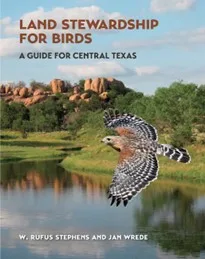
May 2024 Presentation by Rufus Stephens
Land Stewardship for Birds: A Guide for Central Texas
In this revised and re-titled edition of Attracting Birds in the Texas Hill Country: A Guide to Land Stewardship, biologist Rufus Stephens and educator Jan Wrede provide a comprehensive update to their popular and practical handbook that focuses on habitat improvement to benefit birds on properties of all sizes (including residential yards) in Central Texas. Copies of the book will be available for purchase for $50 – cash or check only.
W. RUFUS STEPHENS, retired Texas Parks and Wildlife Department district leader for the 25-county Edwards Plateau, is a certified wildlife biologist with over 30 years of professional experience. He lives in Boerne, Texas.


